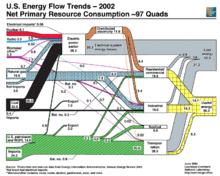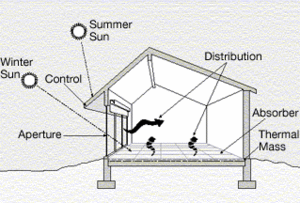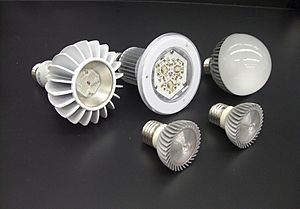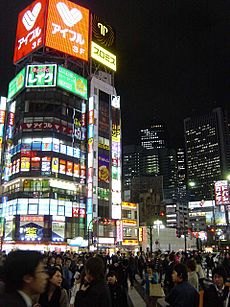Energy conservation facts for kids
For the physical concepts, see conservation of energy and energy efficiency. Energy conservation means to reduce the quantity of energy that is used for different purposes. This practice may result in increase of financial capital, environmental value, national and personal security, and human comfort.
Individuals and organizations that are direct consumers of energy may want to conserve energy in order to reduce energy costs and promote economic, political and environmental sustainability. Industrial and commercial users may want to increase efficiency and thus maximize profit.
On a larger scale, energy conservation is an important element of energy policy. In general, energy conservation reduces the energy consumption and energy demand per capita. This reduces the rise in energy costs, and can reduce the need for new power plants, and energy imports. The reduced energy demand can provide more flexibility in choosing the most preferred methods of energy production.
By reducing emissions, energy conservation is an important method to prevent climate change. Energy conservation makes it easier to replace non-renewable resources with renewable energy. Energy conservation is often the most economical solution to energy shortages.
Contents
Energy tax
Some countries employ energy or carbon taxes to motivate energy users to reduce their consumption. Carbon taxes can allow consumption to shift to nuclear power and other alternatives that carry a different set of environmental side effects and limitations. Meanwhile, taxes on all energy consumption stand to reduce energy use across the board, while reducing a broader array of environmental consequences arising from energy production. The State of California employs a tiered energy tax whereby every consumer receives a baseline energy allowance that carries a low tax. As usage increases above that baseline, the tax is increasing drastically. Such programs aim to protect poorer households while creating a larger tax burden for high energy consumers.
Building design
One of the primary ways to improve energy conservation in buildings is to use an energy audit. An energy audit is an inspection and analysis of energy use and flows for energy conservation in a building, process or system to reduce the amount of energy input into the system without negatively affecting the output(s). This is normally accomplished by trained professionals and can be part of some of the national programs discussed above. In addition, recent development of smartphone apps enable homeowners to complete relatively sophisticated energy audits themselves.
Building technologies and smart meters can allow energy users, business and residential, to see graphically the impact their energy use can have in their workplace or homes. Advanced real-time energy metering is able to help people save energy by their actions.
In passive solar building design, windows, walls, and floors are made to collect, store, and distribute solar energy in the form of heat in the winter and reject solar heat in the summer. This is called passive solar design or climatic design because, unlike active solar heating systems, it doesn't involve the use of mechanical and electrical devices.
The key to designing a passive solar building is to best take advantage of the local climate. Elements to be considered include window placement and glazing type, thermal insulation, thermal mass, and shading. Passive solar design techniques can be applied most easily to new buildings, but existing buildings can be retrofitted.
Transportation
In the United States, suburban infrastructure evolved during an age of relatively easy access to fossil fuels, which has led to transportation-dependent systems of living. Zoning reforms that allow greater urban density as well as designs for walking and bicycling can greatly reduce energy consumed for transportation. The use of telecommuting by major corporations is a significant opportunity to conserve energy, as many Americans now work in service jobs that enable them to work from home instead of commuting to work each day.
Consumer products
Consumers are often poorly informed of the savings of energy efficient products. A prominent example of this is the energy savings that can be made by replacing an incandescent light bulb with a more modern alternative. When purchasing light bulbs, many consumers opt for cheap incandescent bulbs, failing to take into account their higher energy costs and lower lifespans when compared to modern compact fluorescent and LED bulbs. Although these energy-efficient alternatives have a higher upfront cost, their long lifespan and low energy use can save consumers a considerable amount of money. The price of LEDs has also been steadily decreasing in the past five years, due to improvement of the semiconductor technology. Many LED bulbs on the market qualify for utility rebates that further reduce the price of purchase to the consumer. Estimates by the U.S. Department of Energy state that widespread adoption of LED lighting over the next 20 years could result in about $265 billion worth of savings in United States energy costs.
The research one must put into conserving energy is often too time consuming and costly for the average consumer, when there are cheaper products and technology available using today's fossil fuels. Some governments and NGOs are attempting to reduce this complexity with ecolabels that make differences in energy efficiency easy to research while shopping.
To provide the kind of information and support people need to invest money, time and effort in energy conservation, it is important to understand and link to people's topical concerns. For instance, some retailers argue that bright lighting stimulates purchasing. However, health studies have demonstrated that headache, stress, blood pressure, fatigue and worker error all generally increase with the common over-illumination present in many workplace and retail settings. It has been shown that natural daylighting increases productivity levels of workers, while reducing energy consumption.
In warm climates where air conditioning is used, any household device that gives off heat will result in a larger load on the cooling system. Items such as a stove, dish washer, clothes dryer, hot water and incandescent lighting all add heat to the home. Low power or insulated versions of these devices give off less heat for the air conditioning to remove. The air conditioning system can also improve in efficiency by using a heat sink that is cooler than the standard air heat exchanger such as geothermal or water.
In cold climates heating air and water is a major demand on household energy use. By investing in newer technologies in the home, significant energy reductions are possible. Heat pumps are a more efficient alternative to using electrical resistance heaters for warming air or water. A variety of efficient clothes dryers are available, and the classic clothes line requires no energy, only time. Natural gas condensing boilers and hot air furnaces increase efficiency over standard hot flue models. New construction implementing heat exchangers can capture heat from waste water or exhaust air in bathrooms, laundry and kitchens.
In both warm and cold climate extremes, airtight thermal insulated construction will largely determine the efficiency of a home. Insulation is added to minimize the flow of heat to or from the home, but can be labor-intensive to retrofit to an existing home.
Energy conservation by the countries
Asia
Despite the vital role energy efficiency is envisaged to play in cost-effectively cutting energy demand, only a small part of its economic potential is exploited in the Asia. Governments have implemented a range of subsidies such as cash grants, cheap credit, tax exemptions, and co-financing with public-sector funds to encourage a range of energy-efficiency initiatives across several sectors. Governments in the Asia-Pacific region have implemented a range of information provision and labeling programs for buildings, appliances, and the transportation and industrial sectors. Information programs can simply provide data, such as fuel-economy labels, or actively seek to encourage behavioral changes, such as Japan’s Cool Biz campaign that encourages setting air conditioners at 28-degrees Celsius and allowing employees to dress casually in the summer.
European Union
At the end of 2006, the European Union (EU) pledged to cut its annual consumption of primary energy by 20% by 2020. The 'European Union Energy Efficiency Action Plan' is long-awaited. Directive 2012/27/EU is on energy efficiency.
As part of the EU's SAVE Programme, aimed at promoting energy efficiency and encouraging energy-saving behaviour, the Boiler Efficiency Directive specifies minimum levels of efficiency for boilers fired with liquid or gaseous fuels.
India
Petroleum Conservation Research Association (PCRA) is an Indian government body created in 1977 and engaged in promoting energy efficiency and conservation in every walk of life. In the recent past PCRA has done mass media campaigns in television, radio & print media. An impact assessment survey by a third party revealed that due to these mega campaigns by PCRA, overall awareness level have gone up leading to saving of fossil fuels worth crores of rupees(Indian currency) besides reducing pollution.
Bureau of Energy Efficiency is an Indian governmental organization created in 2001 responsible for promoting energy efficiency and conservation.
Japan
Since the 1973 oil crisis, energy conservation has been an issue in Japan. All oil based fuel is imported, so indigenous sustainable energy is being developed.
The Energy Conservation Center promotes energy efficiency in every aspect of Japan. Public entities are implementing the efficient use of energy for industries and research. It includes projects such as the Top Runner Program. In this project, new appliances are regularly tested on efficiency, and the most efficient ones are made the standard.
Lebanon
In Lebanon and since 2002 The Lebanese Center for Energy Conservation (LCEC) has been promoting the development of efficient and rational uses of energy and the use of renewable energy at the consumer level. It was created as a project financed by the International Environment Facility (GEF) and the Ministry of Energy Water (MEW) under the management of the United Nations Development Programme (UNDP) and gradually established itself as an independent technical national center although it continues to be supported by the United Nations Development Programme (UNDP) as indicated in the Memorandum of Understanding (MoU) signed between MEW and UNDP on June 18, 2007.
New Zealand
In New Zealand the Energy Efficiency and Conservation Authority is the Government Agency responsible for promoting energy efficiency and conservation. The Energy Management Association of New Zealand is a membership based organization representing the New Zealand energy services sector, providing training and accreditation services with the aim of ensuring energy management services are credible and dependable.
Sri Lanka
Sri Lanka currently consumes fossil fuels, hydro power, wind power, solar power and dendro power for their day to day power generation. The Sri Lanka Sustainable Energy Authority is playing a major role regarding energy management and energy conservation. Today, most of the industries are requested to reduce their energy consumption by using renewable energy sources and optimizing their energy usage.
Turkey
Turkey aims to decrease by at least 20% the amount of energy consumed per GDP of Turkey by the year 2023 (energy intensity).
United States
The United States is currently the second largest single consumer of energy, following China. The U.S. Department of Energy categorizes national energy use in four broad sectors: transportation, residential, commercial, and industrial.
Energy usage in transportation and residential sectors, about half of U.S. energy consumption, is largely controlled by individual consumers. Commercial and industrial energy expenditures are determined by businesses entities and other facility managers. National energy policy has a significant effect on energy usage across all four sectors.
Other pages
See also
 In Spanish: Conservación energética para niños
In Spanish: Conservación energética para niños





